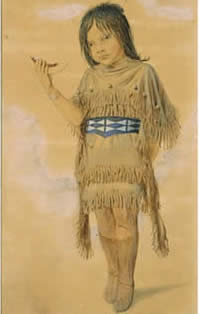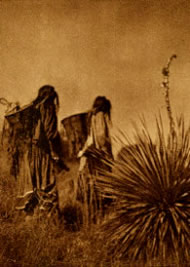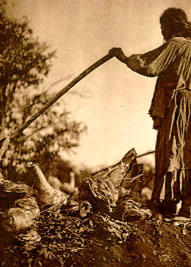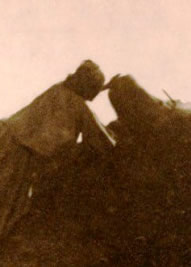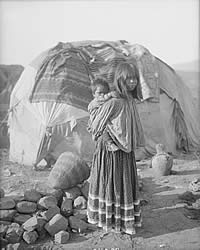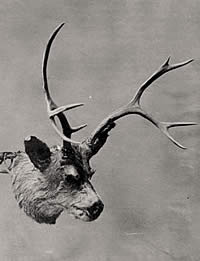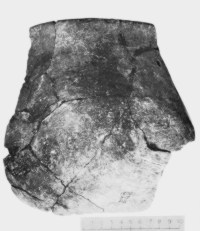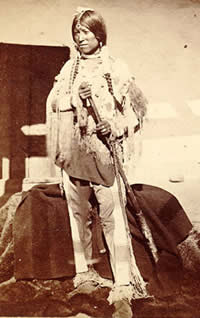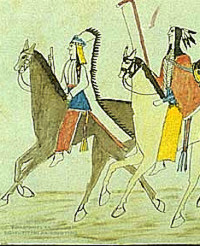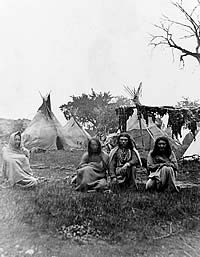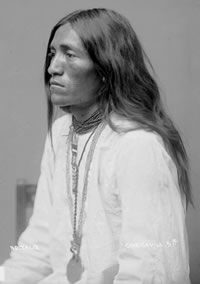Apache—without a doubt, the name
is one of the most evocative of all Indian groups, charged
with history and popularized in books and movies. However, the name
Apache is a generic one, applying to several tribes that have shared—but
unique—histories. The Apache include groups that have been
known at various times as Apachu, Lipan, Mescalero, Faraones, Gilenos,
Natagee, Querechos, Tontos, Ypandi, and Yutaglen-ne, to name but
a few.
Many federally recognized tribes in the United States today have
names that were given to them by Europeans or by other Indian groups
in early historic times. In some cases, Spaniards or other Europeans
assigned a name based on physical appearances, such as hairstyle,
or a cultural aspect of the group. In other cases, the first name
given a native people was based on a place. For example, Querecho was
the name given to the native people on the Southern Plains by the
people who lived in Pecos Pueblo who had close trade relations with
that group of Apache.
The term Apache dates from the year 1601 when Onate used the term Apachu to
refer to the people occupying the Southern Plains. The name was later
changed by the Spanish to “Apache,” but the name was
not universally used until the nineteenth century. Prior to that time,
both they and others used distinct names for their various groups.
Manuel Merino in 1804 wrote:
They can be divided into nine principal groups…. The
names…in their language [are]….: Vinienctinen-ne,
Sagatajen-ne, Tjusccujen-ne, Yecujen-ne, Yntugen-ne, Sejen-ne,
Cuelcajen-ne, Lipanjen-ne, and Yutaglen-ne. We have replaced these
naming them in the same order: Tontos, Chircagues [Chiricahuas],
Gilenos, Mimbrenos, Faraones, Mescaleros, Llaneros, Lipanes, and
Nabajoes [Navajos], all of them under the general name of Apaches.
A number of Apache peoples have roots in Texas, but during the prehistoric period they lived in the northern Plains and Canada.
As they moved south, they did not settle in the Plateaus and Canyonlands
but, rather, in and around the Southern Plains of Texas, Oklahoma,
and New Mexico. While scholars dispute the route and timing of their
migration south there seems to be fairly clear evidence that the
Querechos and possibly the Teyas whom Coronado met on his march across
the Southern Plains in 1541 were Apaches.
As we can tell from their names, the Apache are not just one group
of people. Either prior to or shortly after their migration south,
they divided into eastern and western groups and both of these geographic
divisions subdivided further. Today they retain those same subdivisions.
The eastern Apache generally occupied the lands and areas of the
Southern Plains. Spanish documents make clear that subdivisions of
the eastern Apache existed from their earliest encounter with those
native peoples. We do not know, however, if these subdivisions were
an artifact of their movement to the south, where separate bands occupied
different regions, or if the subdivisions were a long-standing tradition. Eventually
some Apache names began to take precedence over the variety of earliest
appellations. Mescalero Apache, mentioned as early as 1725, and Lipan
were maintained, while Pelones, Natagees, and Fararones were less
frequently used and eventually disappeared from the documentary record.
The Apache in Texas began a gradual move toward the Plateaus
and Canyonlands during the late seventeenth century and were gradually displaced
by the Comanche as that group pushed them southward. Documents written
by Spanish military officers with many years of experience on the
northern frontiers and familiar with both the geography and the native
peoples in the region place the Apache in the area of the Plateaus
and Canyonlands by the eighteenth century. One of these military
men, Joseph de Berroteran, wrote that the Apache “came from
the Rio Puerco [Pecos] where it joins with the Rio del Norte [ Rio
Grande].” He warned government officials that, if the presidios
that had been established on the Rio Grande were not maintained,
the Apache would control the Rio Grande from El Paso to San Juan
Bautista (located between modern Eagle Pass and Laredo). Joseph de
Urrutia, another military officer, wrote in 1733 that the Apache
resided along the Pecos, frequently traveling east and west along
the Rio Grande.
The Apache, particularly the Lipan and Mescalero, had a major presence
in the Plateaus and Canyonlands in the early eighteenth-century period.
The westward movement of English-speaking settlers across North America
and the Spanish colonization of the Southwest combined to create great
unrest and turmoil among native peoples. As the Apache were forced
from the Southern Plains by the quickly-moving Comanche, they began
to align themselves with other native peoples, including the Jumano
and Tonkawa, groups with whom they previously had hostile relations
They also sought peace with the Spanish. Those peace efforts resulted
in the establishment of a Spanish mission, Santa
Cruz de San Sabá and
presidio at San Sabá and,
later, the two missions, San Lorenzo de la Santa
Cruz and Nuestra
Senora de Candelaria on the Nueces River, all during the mid-eighteenth
century.
Ultimately, the San Sabá mission was destined to fail because the
Spanish ignored—or were unaware of—the volatile relationships
among native groups. As Maria Wade notes in her 2002 volume on the Native Americans of the Edward Plateau, the Spaniards
made a significant error in establishing the mission :
At issue is the assumption of the Spaniards that they could
be friends with everyone regardless of Native internal enmities,
as well as the political arrogance of making new alliances without
informing former allies, especially when the new alliances were
made with their bitter enemies.
The mis-step by the Spanish led to an assault on the mission, orchestrated by Tonkawa, Comanche, Bidais, Wichita, and
Caddo Indians, all enemies of the Lipan and other Apache.
Mission San Lorenzo de la Santa Cruz, established in 1762, postdates
the disaster at San Sabá. Although it lasted longer, San Lorenzo
was never officially approved and was burned and then abandoned in
1771. Situated on the upper Nueces River at present-day Camp Wood, Texas, the
mission was founded to serve the Lipan Apache. Missionaries reported
that some 3,000 Lipan were at the mission; Spanish reports, however,
indicate that there was a regular coming and going of individual
bands of groups of Lipan. The priests sought to teach
the Lipan to grow corn and other crops. However, raids by hostile native groups plagued the mission and in 1771 it was
abandoned. Curiously, however, the Lipan and Mescalero continued
to frequent the area of this mission and Mission Candelaria in the century
to come, often to grow crops when they could not access other food
In the second half of the eighteenth century and after their mission
on the San Sabá was destroyed, the Apache ranged from the Bolson
de Mapimi to the Rio Grande to the Nueces. In 1772, 300 Lipan Apache
attacked haciendas and pueblos in Coahuila. A Spanish military map
dated 1773 continued to call the Pecos River the “Salado o
rio del Apache del Nataje que la Fora lo llama del Pecho y Danville
de los 7 Rios,” meaning “the Salty River or river of
the Nataje Apache whom Spanish engineer and cartographer Nicolas
la Fora calls the Apache of the Pecos and whom Danville calls the
Apache of the Seven Rivers.” On that same map, several other
Apache groups are shown in or close to the Plateaus and Canyonlands—the
Apaches Jumanes just north of the Lipanes and on the east side of
the Pecos, with the Natajes and Mescaleros depicted on the west side
of the Pecos. Two years later, Juan del Ugarte also noted their presence
in the region. Traveling north of Monclova some 740 miles in an effort
to force the Apache away from Coahuila, he found them on the Rio
San Pedro or Devils River. The Mescalero were, by the late eighteenth century,
roaming the Plateaus and Canyonlands, and Spanish armies repeatedly
found them between the Rio Sabinas, Piedras Negras, and the mouth
of the Pecos, either alone or in the company of Lipan, or other Apache
bands.
The Apache maintained a presence in northern Mexico in subsequent
decades, but the Lipan and Mescalero were often found in the region
of south and Central Texas, particularly on the Nueces, the
San Antonio, and Guadalupe river areas as well as the Colorado. Their presence
on the Pecos River can be well documented in the nineteenth century including
the area of Toyah Creek’s confluence with the Pecos.
The Apache presence in the Plateaus and Canyonlands was quite broad
during the nineteenth century. Manuel Merino, a prominent government
official in Chihuahua, issued a report on the Apache in 1804 that
describes their territory. He wrote that the Apache nation “inhabits
the vast empty expanse living between 20 and 38 degrees of latitude
and 264 and 277 degrees of longitude…to that of La Bahía del
Espiritu Santo.” Elsewhere, Merino described the territories
of the various Apache subdivisions:
[The Faraones] are still quite numerous. They inhabit the mountains
lying between the Rio Grande del Norte and the Pecos, maintain
a close union with the Mezcaleros, and make war on us. The two
provinces of New Mexico and Nueva Vizcaya have been and still are
the scene of their incursions. In both provinces they have made
peace treaties various times, but have broken them every time,
with the exception of a rancheria here or there whose faithful
conduct has obliged us to let them settle at the presidio of San
Elcerio [San Elizario]. They
border on the north with the province of New Mexico, on the west
with the Mimbreno Apaches, with the Mezcaleros on the east, and
on the south with the province of Nueva Vizcaya….[The Mezcaleros]
generally inhabit the mountains near the Pecos River, extending
northward to the edge of the Cumancheria. They approach that territory
in the seasons propitious to the slaughter of bison, and when they
do this, they join with the Llanero tribe, their neighbors….These
Indians usually made their entry through the Bolson de Mapimi whether
they are going to maraud in the province of Coaguila or in that
of Nueva Vizcaya….They border on the west with the Faraon
tribe, on the east with the Llaneros, and on the south with our
frontier of Nueva Vizcaya and Coahuila. Llaneros occupy the plains
and deserts lying between the Pecos and the Colorado…. It
is a very populous tribe, which is divided into three categories:
Natages, Lipiyanes, and Llaneros….[The Lipan] is probably
the most populous of all Apache tribes, and for many years it has
lived in peace on the frontiers of Coahuila and Texas.
|
Other names for Apache:
Apachu, Apaxches, Cuelcajen-ne, Faraones, Gilenos, Natagee, Natajee, Nataxe, Lipan, Lipanjen-ne, Mescalero, Mimbreno, Querechos, Azain, Duttain, Negain, Pelones, Sagatajen-ne, Sejen-ne, Siete Rios, Teyas, Tjusccujen-ne, Tontos, Vinienctinen-ne, Yecujen-ne, Yntugen-ne, Ypandi, and Yutaglen-ne
|
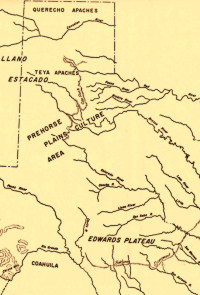
Southern Plains and southwest Texas in pre-horse times, showing location of early Apache groups, Teyas and Querecho, in Panhandle area. (Map after Newcomb 1961: Map 2.) |
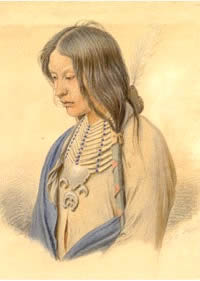
Lipan Apache brave wearing breastplate. Watercolor by Frederich Richard Petri, circa 1850s. The artist lived in the area of Fredericksburg, Texas, and was on peaceful terms with many of the native peoples. |
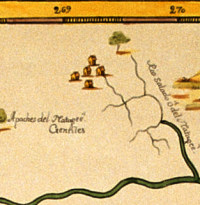
Rancherias of the Natagee, an early Apachean group, are shown in a 1729 map of Coahuila, Nuevo Leon, and Texas in 1729, drawn by Francisco Alvarez Barreiro. Note the Pecos River in west Texas is also identified as Rio de Natagee. Click to see larger image. |
|
Documentation of Apache Groups in
Plateaus/Canyonlands in 1700s
(View full table)
| Source |
Description |
| Jesuit Priest |
Apaches Fahanos [Faraone] are present north of the Rio Grande
on the Pecos River; Apaches Necayees [Natajee] are east of
Pecos Pueblo in the Southern Plains |
| Joseph Vargas |
The salines near Hueco Mountain are “lands of the
Apaches" |
| Map |
Pecos River is called “rio salado o del Natagee” meaning “salty
river or the river of the Natagee people” |
|
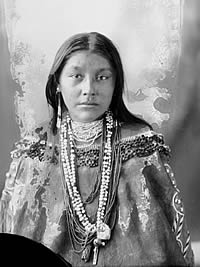
Hattie, Chiricahua Apache, circa 1899. She is wearing traditional hide clothing, with added brass tinklers at neckline, and bone and shell bead necklaces. |
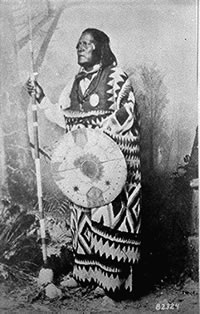
San Juan, a Mescalero Apache chief. National Archives. |
|








